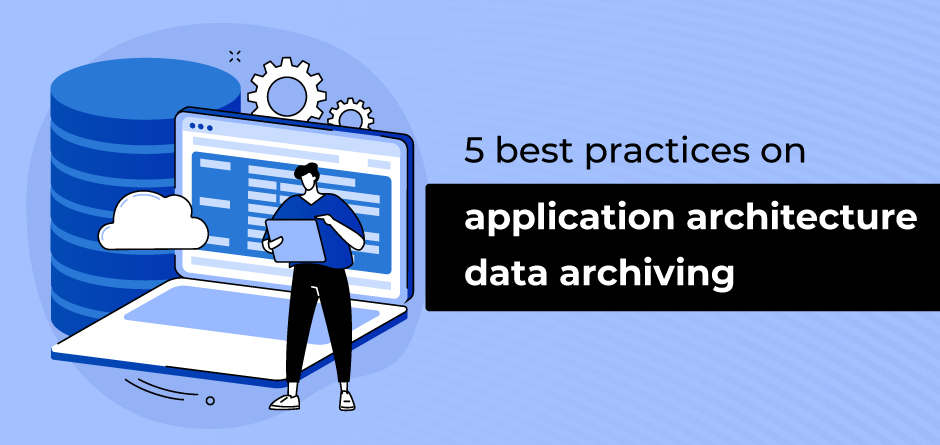
5 Best Practices on Application Architecture Data Archiving
Data Archiving
Data archiving is the practice of recognizing inactive data and removing it from production systems to long-term storage systems. Archival data is stored so that it can be brought into service at any time.
What is Application Archiving in Detail?
Prepare that those applications were real applications that saw your process.
In most cases, Archived Applications consult with applications that have passed through most, if not all, of the appliance process in a previous cycle or year.
It’s a vital part of an information management strategy. The goal is to scale back costs on warm storage while retaining old data needed for future reference or analysis and data needed for regulatory compliance. A data archive is usually built using cold storage tiers, which may hold large amounts of knowledge at the cost of a cup of coffee.
There are many varieties of archival architecture and features, each meeting different needs. However, the minimum requirements are indexing & searching capabilities, which ensure files remain easily accessible.
Why is Data Archiving Important?
A data archiving plan is a vital part of your data lifecycle management policy, providing you with how to retain information while staying within an inexpensive storage plan value. An information archiving implementation typically involves supporting tooling and automation, which help drive efficiency into the method. Here are key functions of an information archiving solution:
- Data discovery is a data archiving solution that can help admins and end-users simply find files, including spreadsheets, documents, and presentations.
- Data management is a data archiving solution that can facilitate locating your redundant data and taking it away or removing aging files from your files servers.
- Data visibility is a data archiving solution that analyzes, classifies, and indexes data before storing it on your servers. This process ensures you’ll be able to perform searches and gain insights easily.
- Data compliance is a data archiving solution that prepares responses to requests automatically, including compliance audits, business queries, and litigation.
Data Archiving Considerations
The main advantage of knowledge archiving is the ability to significantly reduce storage costs. However, a knowledge archive isn’t ideal for all use cases. You must not, for instance, use an information archive rather than a backup solution.
Data Archiving vs. Backup
Data archives and data backups are used as storage device repositories; the two don’t provide value.
A data backup could be a copy of knowledge created for the aim of protecting and recovering data. Backups of information have crucial information required for easy recovery during data loss or other mishaps.
A data archive comprises data kept for the aim of retaining the data for the future. Data archives mostly retain infrequently accessed data, which isn’t critical for recovery or needed for ongoing business continuity.
Data Archiving and Data Lifecycle Management
A data archive and an information lifecycle management perform different functions.
Data lifecycle management processes manage the whole lifecycle of knowledge, from the time a bit of knowledge is made until it’s deleted. Companies create data lifecycle management policies, which are enforced by administrators and management tools.
Data archiving is usually created as a part of an overall data lifecycle management program. Organizations create data archiving policies, and therefore the process is then fully automated by archiving software.
Data Archive and Compliance
Companies can use data archives to retain general information and to retain information needed for compliance.
A data archive will retain information needed for compliance purposes. This data is commonly retained for future compliance audits. During this case, the info must be easily accessible to confirm that regulatory entities can quickly reference the information.
Companies often use data archives to store aging data of all types. Some data, like corporate information, may be kept in keeping with company policies. Other styles of data, like private information, must be compliant with relevant regulations. During this case, there are certain regulations and standards the archive must meet to make sure compliance.
5 Data Archiving Best Practices
Creating a Robust Data Archiving Strategy
Here are several best practices to contemplate when creating your own data archiving strategy.
Identify and Type Data Before Archiving.
Take a glance at your data and make a listing. Categorize data into types, then prioritize, carefully considering which data is required for ongoing operations and which might be moved to the archive. If you wish to archive both structured and unstructured data, determine whether you wish them stored in different repositories or one centralized archive.
Synchronize Data Archival and Data Lifecycle Management
A data archive has a sway on the information lifecycle. Once you create your archival plan, consider the lifecycle of the archived data. As an example, ask yourself how long you would like to retain archival data and when archival data should be purged. Improve your data lifecycle management strategy accordingly. Be as specific as possible.
Action for Regulatory Compliance
Make sure that your archive strategy is compliant with relevant compliance regulations. If you would like to enforce strict compliance standards on half the archival data, the opposite archival data is easily stored. You may want to contemplate creating two separate pieces of information.
Select the Correct Archiving Tool
Many kinds of solutions will help support your data information strategy. Some tools are dedicated to data information, while other solutions offer end-to-end data solutions with built-in information capabilities. The foremost important feature of any tool is an efficient computer program.
Develop an Information Archiving Policy
Once you have assessed all the necessities for your data archive strategy, you’ll be able to create a comprehensive data archiving policy that documents all important procedures and processes. The policy must have all data archiving criteria and mechanisms, as particular roles and circumstances determine when and who can see archived data.
RECENT POSTS
CATEGORIES
